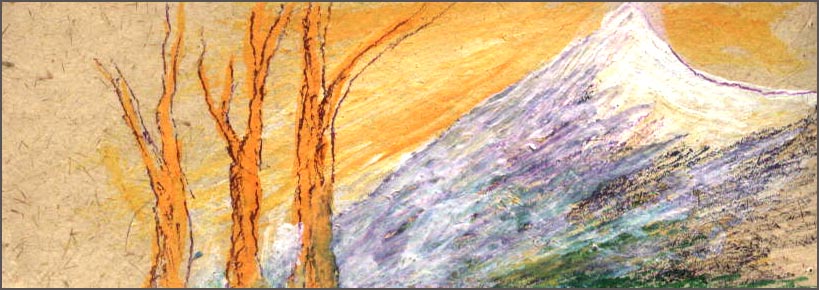

THE IMPACT OF BUDDHIST SCULPTURE AND PAINTING ON ANDHRA Dr.Sanjiva Dev |
Such an exquisite relief from Amaravati entitled “Adoration of the feet of Buddha”, which is now in the Madras Museum, is one of the best aesthetically enchanting pieces. Symmetrical compositions in art are not always peasing to the eye and hence the masterpieces throughout the world are composed in asymmetrical form. But “Adoration of the Feet of Buddha” was done in a symmetrical form and yet it is a piece of inanimate stone which is static, it seems to be full of movement. In the upper part of the sculpture there are visible the feet, in the centre; there are seated two women in the left and two women in the right of the Buddha’s feet. Both the angular and round curves of the bodies as well as the hands and legs of the four women are rhytrhmically moving. Both the compositional harmony and contrast in the postures and gestures are balanced in cadence. The facial expressions of the figures reflect their inner trace. In a single figure of sculpture the charm of composition would not be so superb as in that of a group composition. An Amaravati relief of group composition, showing several mithunas or couple, is a living rhythm in stone. In this piece is also seen Siddhartha in his place. Movement. Rhythmic movement and Lyrical movement, flow through the stone. The curved line has nowhere, it seems, obtained such an enchantment than at Amaravathi “The Toilet”, “The Secene of Enlightenment, “Adoration of the Stupa” “Nanada and Sundari” etc, are some of the masterpices of Amaravati Sculpture. The distinctive characteristic of the Buddhist sculpture in Andhra is, it gave greater prominence to the depiction of secular subjects than that of religious ones. |
The Buddhist sculptors created greater number of men, women, children, trees, beasts and birds than that of gods in their art; they sought; delight in depicting the scenes from the daily life of common people; the human frailties, live and hatred, amities and animosities, unions and separations, song and dance, toilet and make up, births and deaths had never escaped the aesthetic vision as well as the artistic creation of the Buddhist artists of those times. The names of those masters have remained unknown while those of their Royal patrons have been well known. It is a pity, the name of the old masters in the spheres of architecture, sculpture and painting in India were hidden in obscurity ! Those old masters had merged in the ocean of oblivion while their masterpieces have remained immortal! In the history of Buddhist sculpture in Andhra, lkshwaku kings were next to the mighty Satavahanas. After Amaravati, the important Buddhist art centre is Nagarjunakonda are situated on the bank of river Krishna. The lkshawakus dynasty reigned in the Krishna Valley from 250 A.D., to 340 A.D. lkshawakus were the feudal vassals of the Satavahanas and both of them were relatives too. The lkshwaku dynasty was founded by Siri Chanti Mul; Vijayapuri was their capttal; although he was a follower of Brahmanism his brothers by names Himm-asirinika and Chanki Siri were Buddhists by faith. The sculpture of Amaravati had cast its reflections over Nagarjunakonda and thus many of the Amaravati sculptures were repeated in them. Buddha was sculpted there, at Sriparvata, both as an anthropomorphic figure and as a symbolic form. Although the lkshwaku kings were the followers or Brahmanism, their queens were the votaries of Buddha and that was why such exquisite Buddhist sculpture |
flourished there. Some figures in Amaravati have the apparel of the Greek type while those at Nagarjunakonda have that of seythian type. The sculptors of Nagarjunakonda sculpted diversified subjects. Not only religious themes but also various mundane ones had found their expression in those sculptures. The sculptures of Nagarjunakonda are subtler than those of Amaravati. The Nagarjunakonda sculptures are lyrics while those of Amaravati are epics. In one of those sculptures is illustrated a scene in which a lady rejects the goblet of wine offered by her lover. The expression of her aversion is only worth to be painted by the sensitive brush of a painter rather than by the chisel of a sculptor; yet, the chisel had dome it! What a lyrical sculpture it is!! Another Nagarjunakonda sculpture depicts an amorous couple. In that sculpture, on the left wrist of a lady has perched a parrot, and the lady, who is in anguish, tries to offer something to the parrot. Her lover standing beside her smiles in contentment. That sculpture resembles a scene described in the Sanskrit poetic work entitled “Amarasatakam”. The Buddhist sculptors or Nagarjunaknoda had excelled those of Amaravati in technique and treatment; they were profoundly talented in giving aesthetic expression to their delicate emotions in their sculptures. It seems Nagarjunakonda sculptors were more cultured, more refined and more enlightened than those of Amaravati. That is why the sculptures at Nagarjunakonda rare more advanced in every phase of emotional expression and artistic execution than those at Amaravati. In the Buddhist sculpture of Andhra, Amaravati and Nagarjunakonda stand out as the eminent centers of artistic consummation. The sensitive creations of these two centers are world- |